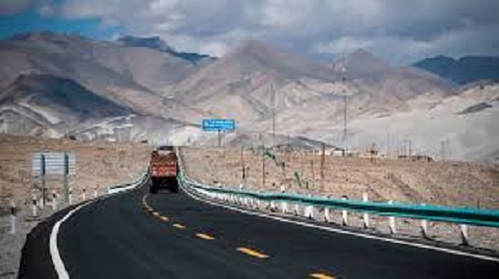New Delhi (IANS) Giving China a renewed status in contemporary times, its president Xi Jinping’s brainchild One Belt One Road (OBOR) is a massive development project that was announced in 2013. With the intent of enhancing connectivity and cooperation among 78 countries across Asia, Africa, and Europe, this project has had the world watching South Asia.
Also known as the Belt and Road Initiative (BRI), the proclaimed purpose of this initiative was to restore the ancient silk route that connected Europe and Asia. However, over the years, with initiating a massive network of road, railways, maritime ports, power grids, oil and gas pipelines, and associated infrastructure projects, its scope has expanded to include more new territories—and new concerns as well.
The two parts of the OBOR project are the ‘Silk Road Economic Belt’ and the ‘21st Century Maritime Silk Road’. The former connects China with Central Asia, Eastern Europe, and Western Europe through land; while the latter is a network of sea-based routes to connect China’s southern coast with the Mediterranean, Africa, South-East Asia, and Central Asia.
Essentially, six economic corridors are the pillars of OBOR: The New Eurasian Land Bridge which connects western China to Western Russia; China-Mongolia-Russia Corridor that connects northern China to eastern Russia via Mongolia; China-Central Asia-West Asia Corridor which connects Western China to Turkey via Central and west Asia; China-Indochina Peninsula Corridor which connects southern China to Singapore via Indo-China; China-Pakistan Corridor which connects southwestern China through Pakistan to Arabia via sea routes; and Bangladesh-China-India-Myanmar Corridor which connects southern China to India via Bangladesh and Myanmar.
This project holds great significance for China as it seeks to boost not only its domestic growth, but is also a crucial part of the country’s strategy for economic diplomacy in the greater global arena.
As it particularly seeks to connect the lesser developed border regions like Xinjiang with adjoining countries, China is on course to ramp up its economic activities, and with the elaborate OBOR network, new markets for Chinese goods is also very much an agenda.
Economically, and with respect to aligning with the development goals of present times, projects under OBOR are said to be green and sustainable development. Besides promoting mutual growth, ‘re-globalisation’ and ‘new regionalism’ are its missions.
Re-globalisation refers to rebuilding an inclusive and equitable global economy, that is essentially de-westernising and decentralising the prevailing dynamics. New regionalism refers to economic corridors in contrast to conventional economic unions and zones.
Pertinently, in 2012, just before OBOR was initiated, China had troubled diplomatic and economic relations with the world, and with severe environmental pollution and industrial over capacity, China’s local economy was on the verge of collapsing.
Internally, it is reasoned that with improved connectivity between China’s poor and richer provinces, it will enhance economic integration and bring about regionally balanced growth. Likewise, the effect is sought beyond China’s national borders.
Countries like Kyrgyzstan and Tajikistan are in support of OBOR for the massive investments China is bringing into their economies.
Further, China has announced investments of more than $1 trillion in numerous infrastructure projects in participating countries and is funding them by offering low-cost loans. However, such associations seldom conclude with commercial exchanges.
China is widely accused of debt-trap diplomacy, whereby the financial relations with the creditor country extends debt to a borrowing nation to enhance the lender’s political leverage. The intention is to extract critical concessions that are political and decisive, when the debtor country is unable to repay.
India’s close neighbour Nepal is the latest country to join OBOR by entering into a partnership to help improve cross-border connectivity with China. Pakistan, on the other hand, is seeking to reap benefits from the $46 billion China Pakistan Economic Corridor (CPEC) in PoK that will connect southwestern China and Pakistan, allowing further access to Arabian Sea routes.
Certainly, these developments are for India to keep a close watch on, lest an alarm goes off.
As expected, given the scale and quantum of this Chinese venture, it has made the Asian giant difficult to ignore. For China, OBOR is its means to rise (and eventually assert itself) as a regional leader.
Although the stated intent behind OBOR is to facilitate smoother cross-border trade and financial inflows from the Eurasian region, the pre-existing border disputes with India impede the ties, compounding certain aspects of our bilateral relations.
The geopolitical implications of OBOR, however, go far beyond south Asia and the Eurasian regions. OBOR may also be viewed as an instrument to counter the status quo of the US as a reigning super power in the global arena.
The strategic investment in infrastructure such as airports and dockyards around the world, which could also be used as military bases should there be a need, point to such a possibility.
But since India is as difficult to ignore as the smaller Asian giant, its concerns not only hold valid, but also has the world paying it attention.
While the Indian security establishment is suspiciously watchful of the new Silk Road initiative, the BRI in the long disputed Pakistan-occupied parts of Jammu and Kashmir has only put India in an uncomfortable spot, straining relations with China. Further, Chinese-built Hambantota port in Sri Lanka is marking its presence in the Indian Ocean Region.
As much as factual realities are taken into account, it is also a matter of perspective to balance economic and political interests to keep a nation’s integrity intact.
OBOR has become an integral element in global geopolitics in a matter of ten years, particularly with regard to South Asia. What appears is that India is looking at its critical immediate concerns and priorities while China is looking towards the world at large.

